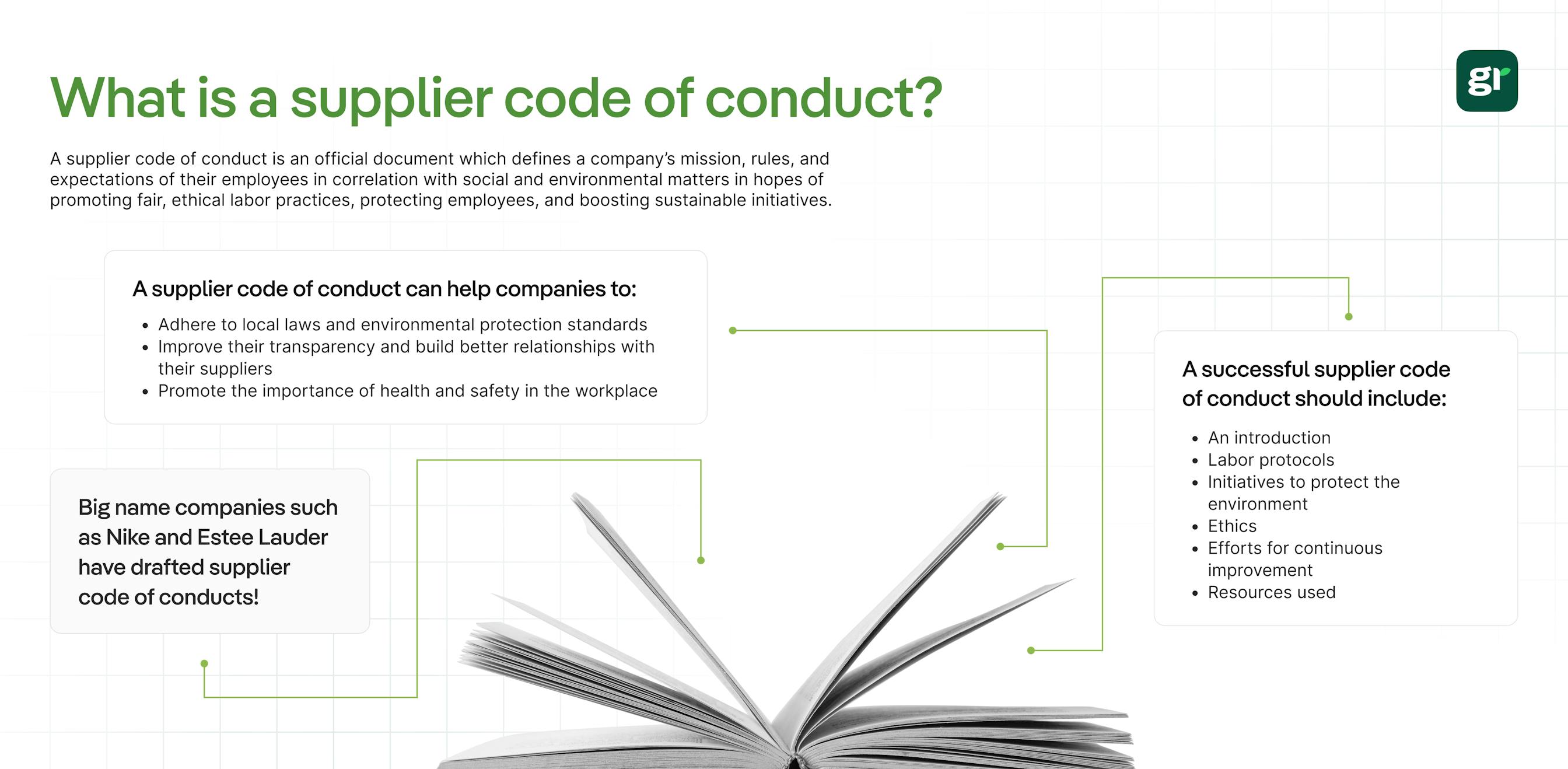
What are the 3 Pillars of Corporate Sustainability?
In this article, we'll explore what the 3 pillars of corporate responsibility are, why they're important, and how businesses can turn them into practical action.
ESG / CSR
Industries



As industrialisation and businesses pick up where they left off following the long-pause exacerbated by the covid-19 pandemic, fair working conditions are more important than ever to ensure employees remain mentally and physically – and that’s where the supplier code of conduct comes in.
A supplier code of conduct can help to create safe, fair, and ethical working conditions by helping companies to develop ethical business practices, following applicable laws, safely monitor their supply chain, and follow business operations and fair business practices as expected.
In this article, we'll explain what a supplier code of conduct is and its main standards, how to write a supplier code of conduct, its benefits, and more.


A supplier code of conduct is an official document that clearly defines the mission of the company, rules, and expectations of their employees in correlation with social and environmental matters. This document strives to implement fair, ethical labor practices, protect employees, and protect the environment in the midst of global warming.
💡 Therefore, its main purpose is to ensure that both suppliers and employees are subject to both safe and fair labor practices.
The main components of a supplier code of conduct often include:
💡 Therefore, its main purpose is to ensure that both suppliers and employees are subject to both safe and fair labor practices.
The main components of a supplier code of conduct often include:
A supplier code of conduct allows the company to provide employees with a clear guide and incentive to improve upon various working conditions, supplier codes, forced labor, reduce greenhouse gas emissions, and practice more responsible sourcing. In addition to benefiting employees at the company, the supplier code of conduct can also be used as a guideline for the requirements the company expects from investors, stakeholders, and suppliers.
A supplier code of conduct is reviewed often, and the document itself should illustrate how these measures are to be monitored and adjusted according to the goals of the company.
👉 Ultimately, the main goal of a supplier code of conduct is to demonstrate financial and social transparency throughout the supply chain in order to establish accountability for common working issues such as human rights, the health and safety of employees, and a company’s impact on the environment.

A supplier code of conduct more often than not follows a similar format, although there are no set requirements for how a supplier code of conduct is organised. Despite this, many supplier codes of conduct include similar principles.
Here are the most common components of a supplier code of conduct document :
As a supplier code of conduct serves as a legally binding document, it’s imperative to outline the document’s main mission at the beginning. The supplier code of conduct must state the country/government it abides to, the parties involved, and the regulations the company is requesting those parties to follow.
This section of a supplier code of conduct delineates the rules regarding employment, encourages the prevention of human trafficking, mitigates child labor, the right to collective bargaining, the protocols to hire interns, working hours, wages and employee benefits, efforts to implement diversity, and the overall health and safety of all employees. This part of the supplier code of conduct is often set to meet the standards of an ISO 45001.
Additional international resources to help draft a supplier code of conduct include:
This section of a supplier code of conduct will delineate a company’s values in emission reduction tactics, the use of hazardous substances, how materials are disposed of with environmental values in mind, how efficient their resources are, and how to mitigate waste. These environmental standards are contingent on the company’s relationship to their supplier and the industry they belong to, and the products or services they collaborate together on to create.
💡 Sometimes, suppliers implement an Environmental Management System, otherwise known as an EMS, or have acquired an ISO 14000 or SA 8000 to comply with these regulations.

A supplier code of conduct often includes ethical guidelines in order to strive towards success and facilitate continual improvement in the marketplace while still keeping social responsibilities in mind.
Topics that pertain to ethics include:
💡 The supplier code of conduct in the U.S. tends to place a heavier emphasis on non-discrimination implementing diversity, equity, and inclusion (DEI) policies to ensure the right to freely chosen employment and fair employment practices regardless of religion, age, gender, union membership or covered veteran status.
A supplier code of conduct isn’t a “one and done” document – it must be continuously monitored for improvement to adhere to current social and environmental standards.
For instance, management systems on how a company sources materials must be ever changing in line with varying business relationships and changing circumstances within a company's supply chain.
Specific topics that may be included in this section could include:
The sources or guidelines that are used to create the supplier code of conduct are often included in the document, similar to how one would cite a source in an academic or peer reviewed paper. These sources or references could include the International Labor Standards, the OECD Guidelines for Multinational Enterprises, or the United Nations Global Compact.
💡 For U.S. supplier code of conducts, compliance laws are often developed in conjunction with the Foreign Corrupt Practices Act (FCPA) and the Dodd-Frank Act.
| Aspect | U.S. Expectations | U.K. Expectations |
|---|---|---|
| Compliance & Legal Framework | The U.S. seeks to prioritise anti-corruption and bribery laws. | The U.K. is more concerned with mitigating forced labor under the Modern Slavery Act of 2015. |
| Ethical & Social Standards | The U.S., as a result of the country being an infamous “melting pot,” places a heavy emphasis on fair labor practices and anti-discrimination policies. | The U.K. focuses on giving back to local and vulnerable communities. |
| Environmental Protocols | The U.S. seeks to boost sustainability in a more corporate & legal manner. | The U.K. aims to accomplish sustainability in a softer, collaborative manner. |
| Reporting | The U.S. places a heavy emphasis on financial disclosures. | The U.K. places a greater emphasis on a company’s social and ethical impact. |
A code of conduct should be written in concise, clear sentence that will make it easy for everyone to understand. In addition to this, when writing your supplier code of conduct – you should be sure to include your most pivotal business values, fundamental principles, and things even you are against: such as poor business conduct or efforts towards implementing good corporate social responsibility.
However, before a company can create a supplier code of conduct, there are a few preliminary measures that should be taken in order to ensure the supplier code of conduct’s success:
💡 According to the UN Global Compact, when it comes to actually writing your supplier code of conduct, it is pivotal to include sections on four crucial elements: human rights, labor, the environment, and anti-corruption.
However, it is key that your values regarding each of these common elements of any code of conduct are written to fit your specific audience. In other words, the code should be aligned to the mission values you have already previously stated to customers, employees, and other supplier relationships – don’t add elements to your code of conduct that you can’t effectively act on.
👉 After writing your code of conduct, it’s a good idea to have it reviewed by a legal counsel. All of this may seem time intensive, but writing a supplier code of conduct could prove very useful for your company.

There are multiple benefits to implementing a supplier code of conduct into your business model, such as working to ensure environmental protection, preserving intellectual property rights, promoting occupational safety, environmental responsibility in business activities and business dealings, and working to minimise adverse effects by abiding by local laws.
Here are a few more reasons why drafting a supplier code of conduct benefits companies in the U.S.:
Ultimately, a supplier code of conduct can also encourage a company to become more sustainable, by creating better transparency amongst their employees, stakeholders, and suppliers. The improved transparency following the implementation of a supplier code of conduct can prevent a company from experiencing allegations such as greenwashing.
👉 Most importantly, a supplier code of conduct can help to maintain a company’s image if there is a mishap between the company and the supplier. If a company sources materials from abroad, a supplier code of conduct is imperative – as it will help to enforce environmental protocols or working conditions in places where these regulations are not well established.

Some of your favorite brands may be more committed to the rights of their employees than you think.
Here are a few examples of brands who have implemented a supplier code of conduct into their business, and strive to improve their working conditions on a continual basis.
This popular American sports-wear company has altered their supplier code of conduct several times, which shows that Nike remains dedicated to ensuring safety and equal rights amongst their employees.
Some new requirements added to their improved supplier code of conduct include to ensure that individual facilities develop an internal Code of Conduct to provide safety in correlation with local legislation, to protect vulnerable workers and prevent child labor, improve their efforts to only allot those who meet the age requirements to participate in hazardous working to do so.
This popular beauty brand also adheres to the ideals of a supplier code of conduct. Estee Lauder bases their supplier code of conduct off of the internationally recognised standards – such as the Universal Declaration of Human Rights and International Labor Organisation’s Conventions.
💡 The main principles of their supplier code of conduct include to engage in lawful and ethical business practices, promote respect, equality, and diverse practices in the workplace, and to ensure that all workers feel safe and healthy whilst maintaining the state of the environment and the community.
The world’s most popular technology brand has one of the most extensive supplier code of conducts ever.
Apple's supplier code of conduct examines the importance of supply chain transparency, consumer trust, compliance with environmental regulations, ethical investments, and even how to engage the community amidst the negative effects of climate change.
Apple also prioritises fair wages, benefits, and contracts amongst its employees, strives to prevent involuntary labor, discrimination or abuse, and aims to mitigate potential child labor.
💡 This in depth supplier code of conduct has helped Apple to build stronger relationships with global suppliers, focus on ESG funds, and drive positive change.
Tesla is a company already known to adhere to environmental justice through their well-known production and marketing of electric cars, but did you know they also value their supplier code of conduct?
As a company that is dedicated to altering our transportation to be more sustainable and reduce global greenhouse gas emissions, the company is also committed to implementing fairness amongst their employees to ensure equality and excellent performance. This popular car company supports the health and safety of their workers, equal wages, freely chosen employment, and freedom of association.

💡 However, it is important to note that supplier code of conduct will only prove effective if the company itself strives to implement the protective policies created by themselves – as a supplier code of conduct may not hold a company accountable for their following actions.
A supplier code of conduct is one of the best ways a company can convey their core values to suppliers and employees alike. It can help create the best business relationships by matching those with similar values, as well as protect businesses from risky interactions or situations amongst employees and suppliers.
Working conditions are already difficult to establish as it is, but a supplier code of conduct can help a company concretely define their values, and better yet – provide them with the necessary incentive to uphold them.
If reading this article about supplier code of conduct has made you interested in reducing your carbon emission to further fight against climate change – Greenly can help you!
Greenly helps companies to also engage their suppliers in their ecological transition. Take control of your carbon impact and engage your suppliers to join you on the journey towards a more sustainable future.
At Greenly we can help you to assess your company’s carbon footprint, and then give you the tools you need to cut down on emissions. We offer a free demo for you to better understand our platform and all that it has to offer – including assistance with boosting supplier engagement, personalised assistance, and new ways to involve your employees.
Click here to learn more about Greenly and how we can help you reduce your carbon footprint.